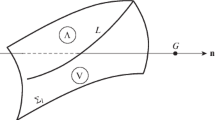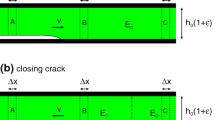Abstract
Analysis is presented of the steady propagation of a crack through a layer of viscous fibers which join two orthotropic elastic half-planes. If the fibers behave linearly, then the stress components at the crack tip are singular, and the strength of the singularity depends upon the crack speed and upon elastic and viscous parameters of the problem. Consideration of more realistic nonlinear behavior near the crack tip results in a finite stress system. Some particular simple models are postulated and analyzed.
Résumé
On présente une analyse de la propagation d'une fissure au travers d'une couche de fibres visqueuses reliant deux demi-plans elastiques et orthotropes.
Si la fibre possède un comportement linéaire, les composantes de la tension à l'extrémité de la fissure sont singulières et la puissance de la singularité depend de la vitesse de la fissure et des paramètres élastiques et visqueux du problème.
Si l'on considère le cas, plus réaliste, d'un comportement non linéaire au voisinage de l'extrémité de la fissure, il en résulte un système de contraintes finies.
Quelques modeles simples et particuliers sont proposés et analysés.
Zusammenfassung
Eine Analyse von gleichmaessiger Rissausbreitung durch eine Schicht von viskosen Fibern, die zwei orthotropische, elastische Halbebene verbindet, wurde praesentiert. Wenn die Fibern sich linear verhalten, sind die Spannungskomponente an der Risspitze singular. Die Staerke der Singularitaet haengt von der Rissgeschwindigkeit und den viskosen und elastischen Parametern des Problems ab. Ein realistischeres, nicht lineares Verhalten in der Naehe der Risspitze hat ein begrenztes Spannungssystem zur Folge.
Similar content being viewed by others
References
1.A.D. McEwan and G.I. Taylor J. Fluid Mech., 26, 1–15 (1966).
J.D. Bernal, C.E.H. Bawn, A.H. Cottrell and F.C. Frank Proc. Roy. Soc., A 282, 1388 (1964).
J.D. Eshelby Proc. Phys. Soc. Lon., A62, 307–314 (1949).
E.H. Yoffe Phil. Mag., 739-750 (1951).
I.N. Sneddon Circolo Matematico di Palermo, Rendiconti, 1, 57–62 (1952).
J.R.M. Radok Q.A.M., XIV 289–298 (1956).
L.A. Galin Contact Problems of the Theory of Elasticity, Moscow, GITTL (1953).
S.G. Lekhnitskii Anisotropic Plates, Moscow, GITTL (1947).
N.I. Muskhelishvili Some Basic Problems of the Mathematical Theory of Elasticity, P. Noordhoff, Groningen (1953).
B.R. Baker J. Appl. Mech., 32, 26–30 (1965).
E.C. Titchmarsh Introduction to the Theory of Fourier Integrals, Oxford (1959).
Yu.P. Zheltov and S.A. Kristianovich Izvestiya AN SSSR, OTN, 5, 3–41 (1955).
G.I. Barenblatt Doklady AN SSSR, 127, 47–50 (1959).
G.I. Barenblatt Advances in Applied Mechanics, 7, Academic Press, N.Y. (1962).
D.S. Dugdale J. Mech. Phys. Solids, 8, 100–104 (1960).
G.I. Barenblatt and G.P. Cherepanov PMM, 24, 4, 667–682 (1960).
Author information
Authors and Affiliations
Rights and permissions
About this article
Cite this article
Baker, B.R. Tearing of viscous fibers. Int J Fract 4, 371–382 (1968). https://doi.org/10.1007/BF00186803
Issue Date:
DOI: https://doi.org/10.1007/BF00186803




